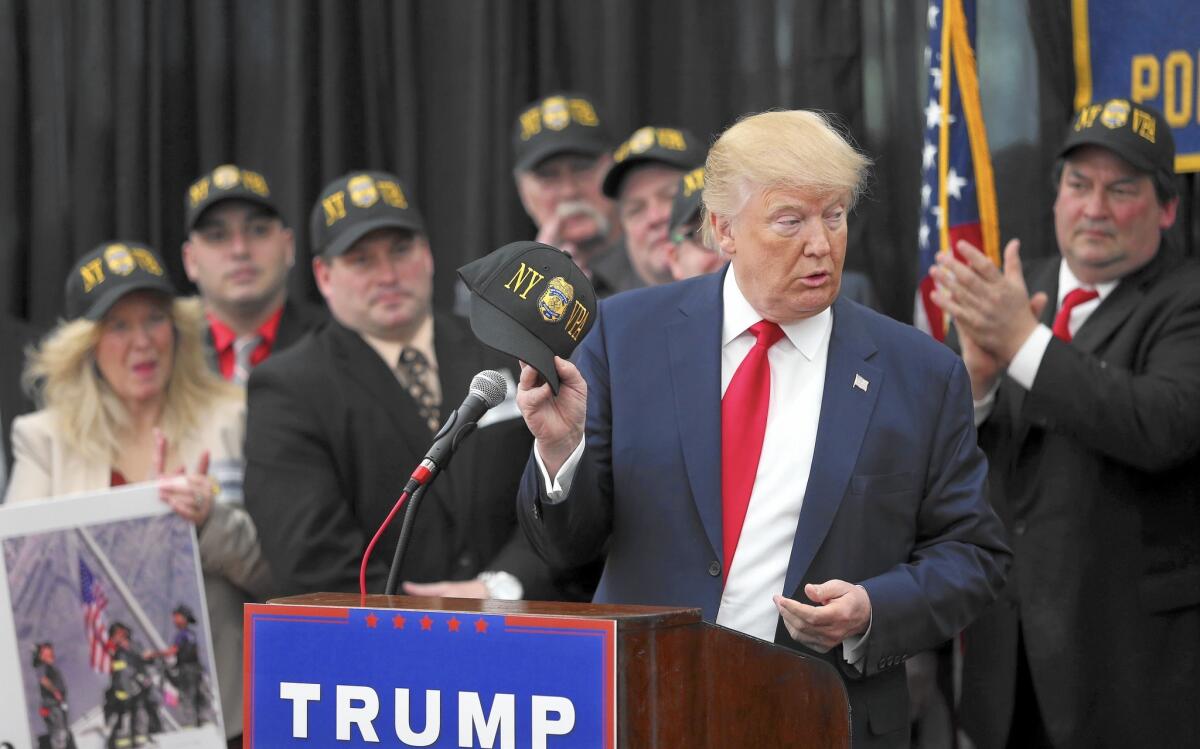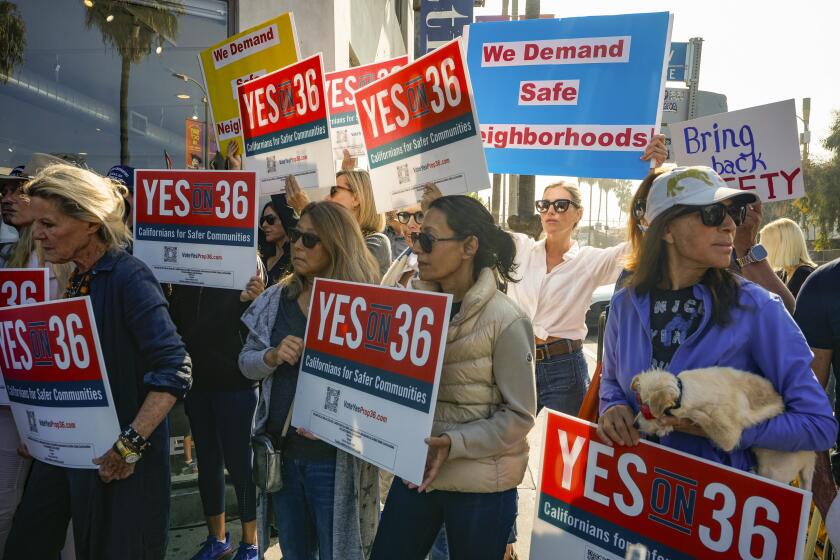Can Donald Trump top 50%? Five things to watch in the New York primary

Donald Trump campaigns in Staten Island, N.Y. He is poised to win his home state primary. The only question is by how much.
- Share via
Reporting from New York — New Yorkers are accustomed to being at the center of the universe, though typically not during presidential primaries. Such contests are usually settled by the time they arrive in this famously combative arena.
Not this year.
Empire State voters will have a New York-size influence over a pair of races dominated by a familiar cast of characters. They include a real estate magnate whose colorful personal life and business exploits have landed him on the cover of their tabloid newspapers for years; the state’s former U.S. senator; and an ex-Brooklynite whose resilience confirms that even decades in pastoral Vermont don’t erase a New Yorker’s street-fighting instincts.
Here are five things to watch in Tuesday’s New York primary:
Can Donald Trump top 50%?
The Republican front-runner is poised to win his home state primary. The only question — and it is important — is by how much. A candidate receiving a majority of the statewide vote will be awarded 14 at-large delegates. The same formula applies in each of New York’s 27 congressional districts, for an additional 81 delegates. So his rivals, Ohio Gov. John Kasich and Sen. Ted Cruz of Texas, have been targeting selected districts where they believe they can keep Trump below 50% and pick off a delegate here or there.
It is no exaggeration to say each one matters as Trump strives for the 1,237 pledged delegates needed to avoid a fight at the Republican Party’s national convention. A good night for Kasich would be winning 10 delegates and for Cruz, five, said David Wasserman, who is closely tracking the nominating contest for the nonpartisan Cook Political Report.
Can Kasich change the campaign narrative?
Yes, the delegate hunt trumps all — pun intended. But perceptions still matter. Kasich has won nothing since his home state primary March 15. Meantime, Cruz picked up 36 delegates after walloping Trump in Wisconsin’s April 5 primary and has steadily added more at state- and district-level party conventions across the country.
A second-place finish could enhance Kasich’s efforts to shoehorn himself back into the campaign conversation as a viable alternative to Trump or Cruz. The race moves next week to contests quite hospitable for him, including primaries in Pennsylvania — where Kasich was born — as well as Connecticut and Maryland. A decent New York finish could offer a modest boost. Third place would be disastrous for the governor.
As goes New York …?
Too big for a winner-take-all result, New York is a lot like California from a presidential primary perspective. So Tuesday’s results may offer some hints of how the GOP race may shape up on June 7 in the Golden State.
California will offer 172 delegates, more than anywhere, under a system much like New York’s. Cruz and Kasich are again likely to target selected congressional districts where they believe they may win a few delegates — and, oddly enough, where the relatively few Republicans in places like Los Angeles and San Francisco can have an outsize effect.
As John Weaver, Kasich’s chief strategist, pointed out, “You can get three delegates in a congressional district that might have 2,000 Republican votes, and they matter just as much as a congressional district that might have 200,000 Republican votes.”
Will Kasich’s performance in the Bronx telegraph his support in Berkeley? If Cruz sweeps Poughkeepsie, will that signal his strength in Pacoima? New York may be telling.
The battle for Brooklyn
Hillary Clinton is strongly favored to win the Democratic primary, but she hasn’t had an easy time. The Democrats’ slugfest has been particularly brutal in Brooklyn, where the electorate in many ways embodies the coalition that propelled Barack Obama to victory. It is racially and ethnically diverse and teems with millennials and progressives.
Clinton, the state’s former senator, sought to establish a beachhead in Brooklyn by making it home to her national campaign headquarters. But the borough’s collection of hipster neighborhoods, with their young entrepreneurs, innovators and art students, has become a potent stronghold instead for the candidate with the thick native accent, Bernie Sanders. About 28,000 supporters crowded into Brooklyn’s Prospect Park on Sunday, the biggest turnout yet for his campaign.
Still, the borough represents a major test for Sanders, the democratic socialist senator from Vermont. He must show his message is starting to resonate more with blacks and Latinos if he is to have any hope of substantially diminishing the huge delegate lead Clinton has amassed.
Rust Belt referendum
Most of the state’s Democrats live in New York City and its suburbs, but Clinton and Sanders have spent considerable time battling upstate. That’s where New York continues to suffer most from the loss of manufacturing jobs.
Clinton highlighted work she did as a senator aimed at reviving industries that were decimated when jobs moved offshore. But Sanders’ message of economic populism has resonated in such communities in earlier primary states, particularly in Michigan, where his attacks on Clinton’s support for international trade treaties helped propel him to an upset victory.
Lately, he has hit Clinton hard for failing to support a $15-an-hour federal minimum wage, another potent theme in communities with mothballed factories. The next stop is Pennsylvania, where the fight is likely to be reprised.
See more of our top stories on Facebook >>
MORE
Why young voters are flocking to Sanders and older ones to Clinton
Sanders’ supporters are lashing out, but here’s how they might be hurting his campaign
Trump is poised to win New York, but by how much matters a lot to delegate-hungry Cruz and Kasich
More to Read
Get the L.A. Times Politics newsletter
Deeply reported insights into legislation, politics and policy from Sacramento, Washington and beyond. In your inbox twice per week.
You may occasionally receive promotional content from the Los Angeles Times.












